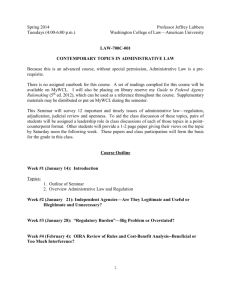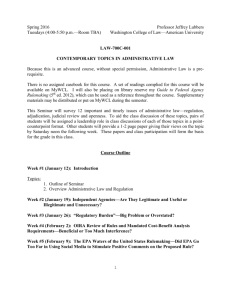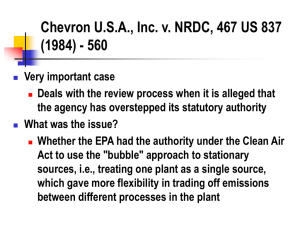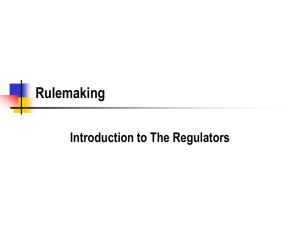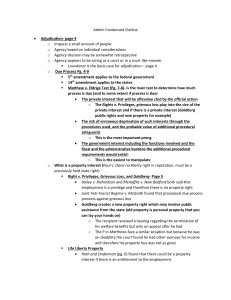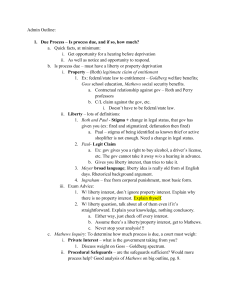Rules as part of policy-making process 1. Exemptions: A. Good Cause
advertisement
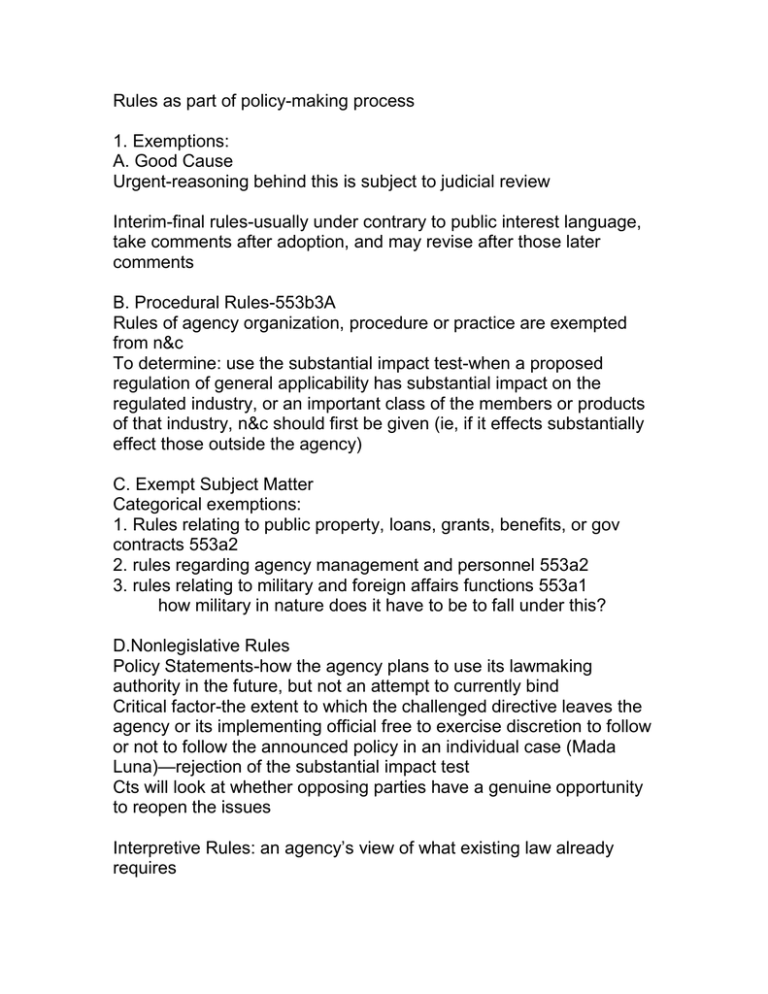
Rules as part of policy-making process 1. Exemptions: A. Good Cause Urgent-reasoning behind this is subject to judicial review Interim-final rules-usually under contrary to public interest language, take comments after adoption, and may revise after those later comments B. Procedural Rules-553b3A Rules of agency organization, procedure or practice are exempted from n&c To determine: use the substantial impact test-when a proposed regulation of general applicability has substantial impact on the regulated industry, or an important class of the members or products of that industry, n&c should first be given (ie, if it effects substantially effect those outside the agency) C. Exempt Subject Matter Categorical exemptions: 1. Rules relating to public property, loans, grants, benefits, or gov contracts 553a2 2. rules regarding agency management and personnel 553a2 3. rules relating to military and foreign affairs functions 553a1 how military in nature does it have to be to fall under this? D.Nonlegislative Rules Policy Statements-how the agency plans to use its lawmaking authority in the future, but not an attempt to currently bind Critical factor-the extent to which the challenged directive leaves the agency or its implementing official free to exercise discretion to follow or not to follow the announced policy in an individual case (Mada Luna)—rejection of the substantial impact test Cts will look at whether opposing parties have a genuine opportunity to reopen the issues Interpretive Rules: an agency’s view of what existing law already requires If an agency has no delegated lawmaking authority, its rules are necessarily interpretive If a statute is drafted in a way that it cannot be implemented until agency issues rules, those rules cannot be interpretive Good test: does it track the statutory language or appear to be directly based on the construction? Has to be rebuttable. The flatter the rule, the less likely it is to be interpretive (8 ft is flat, no other answer allowed), look at level of specificity If interpretive rule changes prior rule, n&c probably needed 2. Required Rulemaking (adjudication) “the choice b/t proceeding by general rule or adjudication is one that lies primarily in the informed discretion of the agency” agencies can choose to address policy issues in adjudication, but then have to allow future adjudications on that issue (but summary judgment okay) Reliance and Retroactivity in adjudicative policy-making Agency can change policy through adjudication, unless unfairly retroactive-cts can find this arbitrary and capricious Five factor balancing test if retroactive and unfair: 1. is case one of first impression? 2. is new rule an abrupt departure from established practice? 3. how much did the party rely on past practice? 4. how big a burden does retroactivity impose? 5. what’s the statutory interest in imposing the new policy to the case at hand? 3. Petitions 553e all members of the public can petition an agency for the issuance, amendment or repeal of the rule 555e-agency required to provide brief statements of reason why petition was denied-cts deferential to denials (record need only contain the petition, pros and cons, and issued explanation) Note: Geller rule-an agency may be forced by ct to institute rulemaking proceedings if a significant factual predicate of a prior decision on a subject has been removed Delay-Congress can impose deadlines (but not usually enforced absence bad faith), cts can compel action unlawfully withheld or unreasonably withheld-looks at 4 factors: 1. time elapsed since agency came under duty to act 2. context of the authorizing statute 3. consequences of delay 4. consideration of admin error, convenience, difficulty in carrying out mandate, or need to prioritize in face of limited resources 4. Waivers Would rule produce harsh or unanticipated consequence? Some cts have held agencies must provide reason for waiver denial State approaches: Florida-required to grant waiver in particular circum: 1. person subject to the rule shows that the purpose of the underlying statute will be or has been achieved by other means, and 2. rule would create substantial hardship or violate principals of unfairness Iowa-required when-application to petitioner would not serve purpose of the statute May when- 1. rule would cause undue hardship, 2. waiver consistent w/ public interest, and 3. wouldn’t prejudice rights of someone else VII Political Control of Agencies NondelegationInvokes both separation of powers (const. assigned all leg. Power to Congress, they can’t transfer) and checks and balances (delegations to agencies are inevitable, but Congress must impose adequate limits on agency discretion) args Modern Standard-congress must provide intelligible standard (to keep political check in place)-allows for meaningful judicial review Benzene case Often, instead of holding delegation, ct will ask agency to clarify Saving a Delegation Amalgamated Meat Cutters-has to be both substantive and procedural limits on agency power (along w/ intelligible principle) Legislative Controls: 1. legislative veto allows Congress to invalidate or suspend agency action by lesser means than statute killed by Chadha, except for some appropriations actions note: state can be different Alts to leg veto 1. line-item veto-unconstitutional 2. congressional review act-requires agencies to submit new rules to Congress, must be accompanied by a report, major rules (economically significant)-can’t become effective until 60 days after submission, non-major can become effective normally Congress can then veto rules through joint, presented resolution (just says no, no reason why) If rule disapproved after effective, must be treated as if never taking effect If rule disapproved, agency cannot reissue rule in substantially same form w/out Congressional permission 3. suspensive veto-only in states-authorizes a legislative committee to suspend leg. Rule for limited period of time Executive Controls Appointments, removal, and executive oversight 1. appointments Buckley and Morrison B-officers of the united states must be chosen pursuant to appointments clause, have significant authority (such as rulemaking, adjudication or enforcement functions) Limitation: congress may allow heads of departments or courts of law, or president alone to appoint inferior officers Who’s inferior?-morrison (someone subject to removal by a higher executive branch officer, supervised by someone by appointment clause—here determined independent counsel inferior) States don’t necessarily follow 2. Removal power to remove is incident to the power to appoint Limit: Independent agency heads can only be removed for good cause-usually com or board w/ specific terms of office Morrison test: do removal restrictions impede president’s ability to perform constitutional duties? Bowsher-Congress can have no formal role in removal 3. Executive Oversight does not apply to independent agencies other controls OMB, purse string control, OIRA W. removed VP’s role in rulemaking in 13258 VIII The Scope of Judicial Review Is it an issue of Fact or Law? Issues of Basic Fact Courts cannot substitute their judgment for that of the agency 3 tests 1. clearly erroneous-ct reverses if is left w/ a definite and firm conviction that a mistake has been committed (61 MSAPA, used by some states) 2. substantial evidence test-ct cannot reverse if a reasonable person could have reached the same conclusion as the agency (like reviewing jury verdict)-706(2)e used for formal proceedings ct must ensure agency has taken a hard look at the important factual issues substantial evidence is more than a mere scintilla (Universal Camera) ct obliged to consider the whole record, so can’t just look at evidence supporting agency decision, must evaluate all evidence applies to agency decisions, not ALJ’s decision (but this will be considered by ct b/c part of record) 3. arbitrary and capricious test 7062a- all informal proceedingsauthorizes cts to reverse agency rulings only if arbitrary, capricious, or abuse of discretion Issues of Law Chevron Doctrine-applies to binding rules: 2 steps: 1. Has Congress directly spoken to the precise question at issue? If yes, ct must give effect to express intent of Congress. Ct should use traditional tools of statutory construction. (better to strike under this step) 2. If the statute is silent or ambiguous, is the agency’s interpretation reasonable? Reviewing ct should presume that Congress has delegated to the agency the task of filling in the gap in some reasonable way Exceptions to Chevron Mead-get Chevron deference when it appears Congress has delegated authority to the agency generally to make rules carrying the force of law and that the agency’s interpretation was promulgated in the exercise of that authority So, formal adj gets Chevron deference, but informal—depends on stat. scheme Skidmore-applies to non-binding rules-uphold agency view if it’s persuasive If agency granted notice and comment, but this wasn’t required (it’s actually a non-legislative rule), Skidmore still the test Note: Levin says no difference b/t Skidmore and Chevron Discretion Review-Is it Adjudication or Rulemaking? Issues of Discretion in Adjudication 706(2)a-arbitrary and capricious test-the ct reverse actions found to be arbitrary, capricious, an abuse of discretion, or otherwise not in accordance w/ law Salameda-agencies cannot abandon an interpretation w/out an explanation Overton Park-cts review whether the agency looked at all relevant factors Review of reasonableness, not rightness Examples of Abuse of Discretion 1. action rests on policy judgment which is so unacceptable as to render action arbitrary 2. The action rests upon reasoning that is so illogical as to render the action arbitrary 3. the asserted or necessary factual premises of the action do not withstand scrutiny under the relevant standard of review 4. the action is, w/out good reason, inconsistent w/ prior agency polices or precedents 5. the agency arbitrarily failed to adopt an alternative solution to the problem addressed in the action 6. action fails to rest on reasoned decisionmaking Issues of Discretion in Rulemaking Arbitrary and capricious standard under section 553 for informal rulemaking Can’t set aside rule that is rational based on consideration of the relevant factors and within the scope of the authority delegated to the agency by the statute (state farm-air bag) Hard Look review Common in federal courts Detailed and intensive inquiry, especially used in review of rulemaking Soft look review Cts give greater deference to decisions where scientific determinations are involved on the basis that the agency has more expertise (Baltimore gas and electric) Comparison Substantial evidence is tougher than arbitrary and capricious, although both are reasonableness tests IX. The Availability of Judicial Review 1.Is it Reviewable? Court must have jurisdiction-703 Plaintiff must plead a recognized cause of action and seek a recognized remedy that provides the needed relief No. Statutory Preclusion of Review APA 701-legislature can preclude judicial review of agency action, or can commit it to agency discretion (Heckler, usually decisions re. resource allocation) Under Bowen, there is a presumption that Congress wants judicial review of agency action, so needs to be clear expressed intent not to allow review Erika Ink-when issue is fact-driven, judicial review fairly useless Actions Committed to Agency Discretion Agency decision is not reviewable when there is no law to apply or meaningful standard against which to judge agency’s discretion-this has never held to be sole reason for denying review 2. Does the P have standing? First, need injury in fact-economic and otherwise 2 views: A. zone of interest test 1. injury and 2. zone of interest-whether the interest sought to be protected is within the zone of interests to be protected or regulated by the statute B. causal connection test of standing 3 parts: 1. injury in fact-an invasion of a legally protected interest which is a. concrete and particularized, and b. actual and imminent 2. causal connection-injury must be fairly traceable to the challenged action of the D, not the result of an independent action by some 3rd party 3. redressibility-must be likely, not merely speculative the injury will be redressed by a favorable decision Association Standing Has standing to sue on behalf of members if: A. one or more members would have standing in their own right B. the interests the ass’n seeks to protect are germane to the org’s purpose, and C. neither the claim nor the relief requires participation of individual members 3. Is it the right time? 3 issues: 1. Finality 2. Ripeness 3. Exhaustion of Remedies 1. Is it Final?-APA 704 Cts only review final orders, this generally means a litigant must complete the administrative process Bennett v. Spear test-1. there must be a consummation of the agency’s decisionmaking process (cannot be tentative or interlocutory), and 2. the action must be one by which rights or obligations have been determined, or from which legal consequences will flow Catch-22 cases-agency recommendation to President not reviewable b/c not final, but President’s decision not reviewable b/c he’s not an agency 2. Is it Ripe? Whether or not the agency has applied its rules to the P Abbott Labs-2 -prong test: 1. fitness of the issues for judicial decision 2. hardship to the parties of withholding ct consideration (major issue) most legislative rules are available for immediate review under this Toilet goods-if not sure agency is going to enforce, wait until enforcement Legal issues are more likely to be found ripe for review 3. Have they exhausted all remedies? By a general rule, ct will not hear a case until a party has exhausted all administrative remedies McCarthy-balancing test b/t individual’s interest in prompt review vs agency’s interest favoring exhaustion 3 exceptions (don’t apply to prisoners): 1. if court doesn’t review now, can’t review later 2. agency lacks capacity for effective relief 3. agency lacks competence to decide the issue (i.e. constitutional issue) Attorney Fees American Rule: each party bears it’s own attny fees, unless proscribed otherwise by statute (ex. Civil rights)—not followed by all states Some states: Ct may award fees to prevailing party in any action resulting in enforcement of an important right affecting the public interest if: 1. significant benefit has been conferred on the general public or large class of persons 2. necessity and financial burden of private enforcement are such as to make the award appropriate, and 3. such fees should not in the interest of justice be paid out of the recovery Stats that provide for fees: Some stats allow ct to require one party to pay other’s fees (ex. Civil Rights) Prevailing P get fees unless special circumstances render it unjust Prevailing D only gets fees if P’s action was frivolous Reasonable Fees Calculated by Lodestar method-calculate hours times reasonable hourly rate Equal Access to Justice Act Agency or court Prevailing party other than US is entitled to fees and expenses when gov’s position is not substantially justified (position has no reasonable basis in both law and fact) Limits on this-only to individual whose net worth does not exceed $2 million or a business whose net worth does not exceed $7 million and does not have more than 500 employees Look at ass’n itself, not members Hourly rate capped at $125, unless an exceptional case such as no other expert available Burden on gov to show position was substantially justified
